 One of the simple pleasures of Florence is walking along the Arno. The principal river of the region bisects the city, with the historic center of the city on the north bank and the "Oltr'arno" (the "other side of the Arno") on the south. Historically, the river was extremely variable, and could go from a placid flow to a raging torrent in just a few days. It's had its share of floods over the years, most recently in 1966, when it overflowed its banks and filled many of the historic buildings with water and mud. (In the church of Santa Croce, they display photos of the immediate aftermath of the '66 flood, which were fascinating and horrifying.) These days, thanks to modern dams upstream, it is a more regulated flow. The Arno as we found it was tranquil, with water gently passing under historic bridges and sunlight sparkling on its smooth surface, broken only by a few kayaks. On both sides, the river is lined with a bit of wild green growth below tall stone walls. On the north side, a street runs right up next to the river wall. On the south side, some blocks have a street beside the river while other blocks have buildings that back right up to the river. The buildings along the river are mostly 3 to 5 story buildings, some shade of yellow or orange (seems to be required in Florence -- Home Depot here must have a whole aisle just for yellow paint), with green shutters.
One of the simple pleasures of Florence is walking along the Arno. The principal river of the region bisects the city, with the historic center of the city on the north bank and the "Oltr'arno" (the "other side of the Arno") on the south. Historically, the river was extremely variable, and could go from a placid flow to a raging torrent in just a few days. It's had its share of floods over the years, most recently in 1966, when it overflowed its banks and filled many of the historic buildings with water and mud. (In the church of Santa Croce, they display photos of the immediate aftermath of the '66 flood, which were fascinating and horrifying.) These days, thanks to modern dams upstream, it is a more regulated flow. The Arno as we found it was tranquil, with water gently passing under historic bridges and sunlight sparkling on its smooth surface, broken only by a few kayaks. On both sides, the river is lined with a bit of wild green growth below tall stone walls. On the north side, a street runs right up next to the river wall. On the south side, some blocks have a street beside the river while other blocks have buildings that back right up to the river. The buildings along the river are mostly 3 to 5 story buildings, some shade of yellow or orange (seems to be required in Florence -- Home Depot here must have a whole aisle just for yellow paint), with green shutters.
 There are several charming bridges that cross the river in various parts of the historic center of Florence, but the star is the Ponte Vecchio, the famous bridge lined with shops on either side. Various bridges have stood in this spot probably since Roman times, with previous bridges being washed away by the Arno's notorious floods. In 1345, a few years after the last bridge had washed away, they built the current one using three stone segmented arches, a design which has stood the test of time. (Segmented arches are wide and shallow, not a complete semi-circle, and allow high water to pass more easily.) Originally the bridge was filled with butcher shops, but these days the shops peddle jewelry, art, and souvenirs. In the center of the bridge, there is a gap in the shops on either side, affording views of the river, and a small square often taken up with street musicians. At night, the shops are closed up, but there are still plenty of people enjoying the romance of the bridge.
There are several charming bridges that cross the river in various parts of the historic center of Florence, but the star is the Ponte Vecchio, the famous bridge lined with shops on either side. Various bridges have stood in this spot probably since Roman times, with previous bridges being washed away by the Arno's notorious floods. In 1345, a few years after the last bridge had washed away, they built the current one using three stone segmented arches, a design which has stood the test of time. (Segmented arches are wide and shallow, not a complete semi-circle, and allow high water to pass more easily.) Originally the bridge was filled with butcher shops, but these days the shops peddle jewelry, art, and souvenirs. In the center of the bridge, there is a gap in the shops on either side, affording views of the river, and a small square often taken up with street musicians. At night, the shops are closed up, but there are still plenty of people enjoying the romance of the bridge.
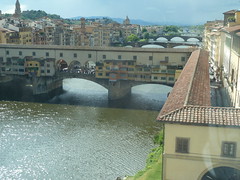 Above the shops on the upstream side of the bridge is the Vasari Corridor, a secret passage connecting the Pitti Palace to the Uffizi and Palazzo Vecchio. When the Medicis moved into the Pitti Palace on the south side of the Arno in the mid-1500s, they wanted to be able to walk to the government offices without having to go out in the street. (Having seen assassination attempts against their ancestors -- Lorenzo the Magnificent was stabbed and his brother Giuliano killed in the cathedral during the Easter service in 1478 -- you can understand the reluctance of the later Medicis to go out in the street.) If you look carefully around central Florence, you can see bits of the corridor, connecting the Palazzo Vecchio to the Uffizi, running along the river for a stretch to get to the bridge, and then along houses on the south side of the river. At one point on the south side, it passes through the church of Santa Felicita, with a balcony opening onto the interior of the church, allowing the Medici to observe the church service from a safe vantage.
Above the shops on the upstream side of the bridge is the Vasari Corridor, a secret passage connecting the Pitti Palace to the Uffizi and Palazzo Vecchio. When the Medicis moved into the Pitti Palace on the south side of the Arno in the mid-1500s, they wanted to be able to walk to the government offices without having to go out in the street. (Having seen assassination attempts against their ancestors -- Lorenzo the Magnificent was stabbed and his brother Giuliano killed in the cathedral during the Easter service in 1478 -- you can understand the reluctance of the later Medicis to go out in the street.) If you look carefully around central Florence, you can see bits of the corridor, connecting the Palazzo Vecchio to the Uffizi, running along the river for a stretch to get to the bridge, and then along houses on the south side of the river. At one point on the south side, it passes through the church of Santa Felicita, with a balcony opening onto the interior of the church, allowing the Medici to observe the church service from a safe vantage.
 One of the simple pleasures of Florence is walking along the Arno. The principal river of the region bisects the city, with the historic center of the city on the north bank and the "Oltr'arno" (the "other side of the Arno") on the south. Historically, the river was extremely variable, and could go from a placid flow to a raging torrent in just a few days. It's had its share of floods over the years, most recently in 1966, when it overflowed its banks and filled many of the historic buildings with water and mud. (In the church of Santa Croce, they display photos of the immediate aftermath of the '66 flood, which were fascinating and horrifying.) These days, thanks to modern dams upstream, it is a more regulated flow. The Arno as we found it was tranquil, with water gently passing under historic bridges and sunlight sparkling on its smooth surface, broken only by a few kayaks. On both sides, the river is lined with a bit of wild green growth below tall stone walls. On the north side, a street runs right up next to the river wall. On the south side, some blocks have a street beside the river while other blocks have buildings that back right up to the river. The buildings along the river are mostly 3 to 5 story buildings, some shade of yellow or orange (seems to be required in Florence -- Home Depot here must have a whole aisle just for yellow paint), with green shutters.
One of the simple pleasures of Florence is walking along the Arno. The principal river of the region bisects the city, with the historic center of the city on the north bank and the "Oltr'arno" (the "other side of the Arno") on the south. Historically, the river was extremely variable, and could go from a placid flow to a raging torrent in just a few days. It's had its share of floods over the years, most recently in 1966, when it overflowed its banks and filled many of the historic buildings with water and mud. (In the church of Santa Croce, they display photos of the immediate aftermath of the '66 flood, which were fascinating and horrifying.) These days, thanks to modern dams upstream, it is a more regulated flow. The Arno as we found it was tranquil, with water gently passing under historic bridges and sunlight sparkling on its smooth surface, broken only by a few kayaks. On both sides, the river is lined with a bit of wild green growth below tall stone walls. On the north side, a street runs right up next to the river wall. On the south side, some blocks have a street beside the river while other blocks have buildings that back right up to the river. The buildings along the river are mostly 3 to 5 story buildings, some shade of yellow or orange (seems to be required in Florence -- Home Depot here must have a whole aisle just for yellow paint), with green shutters.
 There are several charming bridges that cross the river in various parts of the historic center of Florence, but the star is the Ponte Vecchio, the famous bridge lined with shops on either side. Various bridges have stood in this spot probably since Roman times, with previous bridges being washed away by the Arno's notorious floods. In 1345, a few years after the last bridge had washed away, they built the current one using three stone segmented arches, a design which has stood the test of time. (Segmented arches are wide and shallow, not a complete semi-circle, and allow high water to pass more easily.) Originally the bridge was filled with butcher shops, but these days the shops peddle jewelry, art, and souvenirs. In the center of the bridge, there is a gap in the shops on either side, affording views of the river, and a small square often taken up with street musicians. At night, the shops are closed up, but there are still plenty of people enjoying the romance of the bridge.
There are several charming bridges that cross the river in various parts of the historic center of Florence, but the star is the Ponte Vecchio, the famous bridge lined with shops on either side. Various bridges have stood in this spot probably since Roman times, with previous bridges being washed away by the Arno's notorious floods. In 1345, a few years after the last bridge had washed away, they built the current one using three stone segmented arches, a design which has stood the test of time. (Segmented arches are wide and shallow, not a complete semi-circle, and allow high water to pass more easily.) Originally the bridge was filled with butcher shops, but these days the shops peddle jewelry, art, and souvenirs. In the center of the bridge, there is a gap in the shops on either side, affording views of the river, and a small square often taken up with street musicians. At night, the shops are closed up, but there are still plenty of people enjoying the romance of the bridge.
 Above the shops on the upstream side of the bridge is the Vasari Corridor, a secret passage connecting the Pitti Palace to the Uffizi and Palazzo Vecchio. When the Medicis moved into the Pitti Palace on the south side of the Arno in the mid-1500s, they wanted to be able to walk to the government offices without having to go out in the street. (Having seen assassination attempts against their ancestors -- Lorenzo the Magnificent was stabbed and his brother Giuliano killed in the cathedral during the Easter service in 1478 -- you can understand the reluctance of the later Medicis to go out in the street.) If you look carefully around central Florence, you can see bits of the corridor, connecting the Palazzo Vecchio to the Uffizi, running along the river for a stretch to get to the bridge, and then along houses on the south side of the river. At one point on the south side, it passes through the church of Santa Felicita, with a balcony opening onto the interior of the church, allowing the Medici to observe the church service from a safe vantage.
Above the shops on the upstream side of the bridge is the Vasari Corridor, a secret passage connecting the Pitti Palace to the Uffizi and Palazzo Vecchio. When the Medicis moved into the Pitti Palace on the south side of the Arno in the mid-1500s, they wanted to be able to walk to the government offices without having to go out in the street. (Having seen assassination attempts against their ancestors -- Lorenzo the Magnificent was stabbed and his brother Giuliano killed in the cathedral during the Easter service in 1478 -- you can understand the reluctance of the later Medicis to go out in the street.) If you look carefully around central Florence, you can see bits of the corridor, connecting the Palazzo Vecchio to the Uffizi, running along the river for a stretch to get to the bridge, and then along houses on the south side of the river. At one point on the south side, it passes through the church of Santa Felicita, with a balcony opening onto the interior of the church, allowing the Medici to observe the church service from a safe vantage.
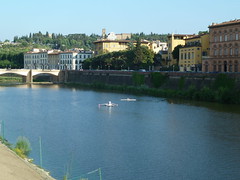

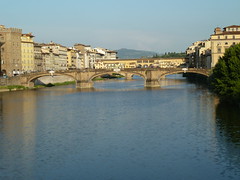
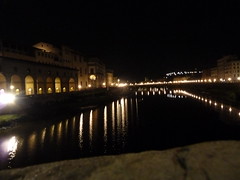

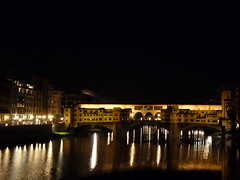

No comments:
Post a Comment